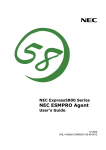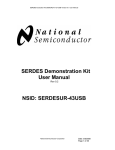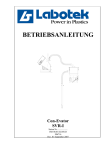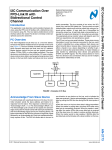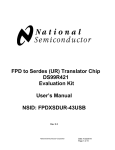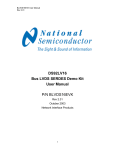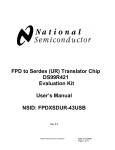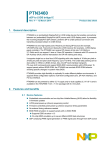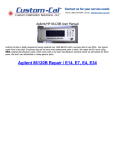Download SERDESUB-16USB User's Guide Table of
Transcript
User’s Guide SNLU100 – April 2012 SERDESUB-16USB User’s Guide Table of Contents TABLE OF CONTENTS..................................................................................................................................... 1 INTRODUCTION:............................................................................................................................................... 2 CONTENTS OF THE DEMO EVALUATION KIT: ............................................................................................. 3 DS90UB901Q/902Q SERDES TYPICAL APPLICATION: ............................................................................... 3 HOW TO SET UP THE DEMO EVALUATION KIT: .......................................................................................... 5 BI-DIRECTIONAL CONTROL BUS AND I2C MODES: ................................................................................... 6 DEMO BOARD POWER CONNECTIONS:....................................................................................................... 6 DS9UB901Q SERIALIZER BOARD DESCRIPTION:....................................................................................... 7 CONFIGURATION SETTINGS FOR THE SERIALIZER DEMO BOARD ......................................................................... 8 SERIALIZER LVCMOS AND FPD-LINK III PINOUT BY CONNECTOR .................................................................... 12 DS9UB902Q DESERIALIZER BOARD DESCRIPTION:................................................................................ 13 CONFIGURATION SETTINGS FOR THE DESERIALIZER DEMO BOARD ................................................................... 14 DESERIALIZER FPD-LINK III PINOUT AND LVCMOS BY CONNECTOR ................................................................ 18 TYPICAL CONNECTION AND TEST EQUIPMENT ....................................................................................... 19 EVALUATION OF THE BI-DIRECTIONAL CONTROL CHANNEL................................................................ 20 CAMERA MODE: ............................................................................................................................................. 20 I2C COMMUNICATION OVER BI-DIRECTIONAL CONTROL CHANNEL IN CAMERA MODE .......................................... 22 DISPLAY MODE: ............................................................................................................................................. 24 I2C COMMUNICATION OVER BI-DIRECTIONAL CONTROL CHANNEL IN DISPLAY MODE .......................................... 26 TROUBLESHOOTING DEMO SETUP............................................................................................................ 28 APPENDIX ....................................................................................................................................................... 30 SERIALIZER AND DESERIALIZER DEMO PCB SCHEMATICS: ............................................................................... 30 BOM (BILL OF MATERIALS) SERIALIZER DEMO PCB: ....................................................................................... 39 BOM (BILL OF MATERIALS) DESERIALIZER DEMO PCB: ................................................................................... 40 SERIALIZER (TX) DEMO PCB LAYOUT: ............................................................................................................ 41 SERIALIZER (TX) DEMO PCB STACKUP: .......................................................................................................... 44 DESERIALIZER (RX) DEMO PCB LAYOUT: ........................................................................................................ 45 DESERIALIZER (RX) DEMO PCB STACKUP:...................................................................................................... 48 SNLU100 – April 2012 SERDESUB-16USB User’s Guide 1 Introduction: Texas Instruments’ Automotive Serdes DS90UB901Q/902Q FPD-Link III evaluation kit contains one (1) DS90UB901Q Serializer board, one (1) DS90UB902Q Deserializer board, and one (1) two (2) meter* high speed USB 2.0 cable. *Note: the chipset can support up to ten (10) meters. The DS90UB901Q/902Q chipset supports a variety of automotive vision applications over a two (2) wire serial stream. The single differential pair (FPD-Link III) is well-suited for direct connections between camera systems and Host Controller/Electronic Control Unit (ECU)/FPGA. The bidirectional control channel of the DS90UB901Q/902Q provides seamless communication between the image sensor and ECU/FPGA. Other typical automotive vision systems may include: rear view, side view camera, lane departure warning, parking assistance, blind spot view, etc. This kit will demonstrate the functionality and operation of the DS90UB901Q and DS90UB902Q chipset. The chipset enables transmission of a high-speed video data along with a low latency bi-directional control bus over a single twisted pair cable. The integrated control channel transfers data bi-directionally over the same serial video link. The transport delivers 16 bits of parallel data together with bidirectional control channel that supports an I2C bus. Additionally, there are six user-configurable GPIO (General Purpose IO) for sending control data. This interface allows transparent full-duplex communication over a single high-speed differential pair, carrying asymmetrical bi-directional control information without the dependency of video blanking intervals. The Serializer and Deserializer chipset is designed to transmit data at PCLK clocks speeds ranging from 10 to 43 MHz and I2C bus rates up to 100 kbps at up to 10 meters cable length over -40 to +105 Deg C. The Serializer board accepts 1.8V/3.3V parallel input signals. FPD-Link III Serializer converts the 1.8V/3.3V LVCMOS parallel lines into a single serialized data pair with an embedded clock. The serial data line rate switches at 28 times the base clock frequency. With an input clock at 43 MHz, the transmission line rate for the FPD-Link III is 1.20Gbps (28 x 43MHz). The user needs to provide the proper 1.8V/3.3V LVCMOS inputs and 1.8V/3.3V LVCMOS clock to the Serializer and also provide a proper interface from the Deserializer output to test equipment. The Serializer and Deserializer boards can also be used to evaluate device parameters. A cable conversion board or harness scramble may be necessary depending on type of cable/connector interface used on the input to the DS90UB901Q and to the output of the DS90UB902Q. The demo boards are not intended for EMI testing. The demo boards were designed for easy accessibility to device pins with tap points for monitoring or applying signals, additional pads for termination, and multiple connector options. 2 SERDESUB-16USB User’s Guide SNLU100 – April 2012 System Requirements: In order to demonstrate, the following are required: 1) Video source with 1.8V or 3.3V LVCMOS parallel interface 2) Microcontroller (MCU) or FPGA with I2C interface bus (I2C master) a. slave clock stretching must be supported by the I2C master controller/MCU. 3) External peripheral device that supports I2C (slave mode) 4) Power supply for 1.8V (required) and 3.3V (optional) Contents of the Demo Evaluation Kit: 1) 2) 3) 4) 5) One Serializer board with the DS90UB901Q One Deserializer board with the DS90UB902Q One 2-meter high speed USB 2.0 cable (4-pin USB A to 5-pin mini USB) Evaluation Kit Documentation (this manual) DS90UB901Q/902Q Datasheet DS90UB901Q/902Q Serdes Typical Application: Camera Module Video Data Image Sensor HSYNC VSYNC Pixel Clock DOUT+ Video Data RIN+ ROUT [13:0] HS,VS DIN[13:0] HS,VS DOUTPCLK RIN- PCLK FPD-Link III GPIO SDA SCL Bidirectional Control Bus Pixel Clock MCU / FPGA GPIO GPIO[1:0] I2C CNTL HSYNC VSYNC GPIO[1:0] SDA SDA SCL SCL DS90UB901Q Serializer DS90UB902Q Deserializer SDA I2C CNTL SCL Bidrectional Control Bus Figure 1. Typical Application The diagram above illustrates a typical application of DS90UB901Q/902Q chipset. The MCU/FPGA can program device registers on the DS90UB901Q, DS90UB902Q, and remote peripheral device, such as a camera. SNLU100 – April 2012 SERDESUB-16USB User’s Guide 3 Camera Module (Video Data + Ctrl) DS90UB901Q Serializer (I2C_CTRL) FPD-LINK III DS90UB902Q Deserializer (I2C_CTRL) (Video Data + Ctrl) Host Controller / FPGA / Video Processor LCD Display Figure 2. Typical DS90UB901Q/902Q Camera System Diagram Figure 1 and Figure 2 illustrate the use of the Chipset (Serializer/Deserializer) in a Camera to Host (MCU/FPGA) Controller. Refer to the proper datasheet information on Chipsets (Serializer/Deserializer) provided on each board for more detailed information. 4 SERDESUB-16USB User’s Guide SNLU100 – April 2012 How to set up the Demo Evaluation Kit: The DS90UB901Q/902Q evaluation boards consist of two sections. The first part of the board provides the point-to-point interface for transmitting parallel video data. The second part of the board allows bi-directional control communication of an I2C bus control of using a MCU/FPGA to programming a remote peripheral device via the Deserailizer. The PCB routing for the Serializer input pins (DIN) accept incoming parallel video data at 1.8V/3.3V LVCMOS signals from J1 IDC connector. The FPD-Link III interface uses a single twisted pair cable (provided). The output pins (ROUT) are accessed through a J7 IDC connector. Please follow these steps to set up the evaluation kit for bench testing and performance measurements: 1) A two (2) meter high speed USB 2.0 cable has been included in the kit. Connect the 41 2 3 4 A pin USB A side of cable harness to the serializer board and the other side of the harness, the 5-pin mini USB jack 1 2 3 4 MINI to the Deserializer board. This completes the FPD-Link III interface connection. NOTE: The DS9UB901Q and DS9UB902Q are NOT USB compliant and should not be plugged into a USB device nor should a USB device be plugged into the demo boards. 2) Jumpers and switches have been configured at the factory; they should not require any changes for immediate operation of the chipset. See text on Configuration settings and datasheet for more details. 3) From the video source, connect a flat cable (not supplied) to the Serializer board and connect another flat cable (not supplied) from the Deserializer board to the controller. Note: For 50 ohm signal sources, provide 1.8V/3.3V LVCMOS input signal levels into DIN[13:0],HS,VS and PCLK and add 50 ohm parallel termination resistors R3-R19 on the DS9UB901Q Serializer board. 4) Connect the Serializer I2C ports to the I2C of the peripheral slave device. Connect the Deserializer I2C ports to the I2C bus of the MCU/FPGA (I2C master). 5) Power for the Serializer and Deserializer boards must be supplied externally through Power Jack (VDD). Grounds for both boards are connected through Power Jack (VSS) (see section below). SNLU100 – April 2012 SERDESUB-16USB User’s Guide 5 Bi-Directional Control Bus And I2C Modes: In order to communicate and synchronize with remote devices on the I2C bus through the bi-directional control channel, slave clock stretching must be supported by the I2C master controller/MCU. The chipset utilizes bus clock stretching (holding the SCL line low) during data transmission; where the I2C slave pulls the SCL line low prior to the 9th clock of every I2C data transfer (before the ACK signal). The bidirectional control bus supports is a I2C compatible interface that allows programming of the DS90UB901Q, DS90UB902Q, or an external remote device (such as a camera or display). Register programming transactions to/from the DS90UB901Q/902Q chipset are employed through the clock (SCL) and data (SDA) lines. These two signals have open drain I/Os and must be pulled-up to VDDIO by external resistors. The boards have an option to use the on-board 1.0KΩ pull-up resistors tied to VDDIO or connected through external pull-ups at the target Host. The appropriate pull-up resistor values will depend upon the total bus capacitance and operating speed. The DS90UB901Q/902Q I2C bus data rate supports up to 100 kbps according to I2C specification. To start any data transfer, the DS90UB901Q/902Q must be configured in the proper I2C mode. Each device can function as an I2C slave proxy or master proxy depending on the mode determined by MODE (M_S) pin. Note the MODE pin is label as M_S on the PCB boards. The Ser/Des interface acts as a virtual bridge between Master controller (MCU) and the remote device. When the MODE (M_S) pin is set to High, the device is treated as a slave proxy; acts as a slave on behalf of the remote slave. When addressing a remote peripheral or Serializer/Deserializer (not wired directly to the MCU), the slave proxy will forward any byte transactions sent by the Master controller to the target device. When MODE (M_S) pin is set to Low, the device will function as a master proxy device; acts as a master on behalf of the I2C master controller. Note that the devices must have complementary settings for the MODE configuration. For example, if the Serializer MODE (M_S) pin is set to High then the Deserializer MODE (M_S) pin must be set to Low and vice-versa. Demo Board Power Connections: The Serializer and Deserializer boards must be powered by supplying power externally through J3 (VDD) and J4 (VSS) on Serializer Board and J4 (VDD) and J5 (VSS) on Deserializer board. Note +2.5V is the MAXIMUM voltage that should ever be applied to the Serializer J3 or Deserializer J4 VDD terminal. Serializer JP1 VDDI and Deserializer VDDIO JP1 must never exceed +4.0V. Damage to the device(s) can result if the voltage maximum is exceeded. 6 SERDESUB-16USB User’s Guide SNLU100 – April 2012 DS9UB901Q Serializer Board Description: The 2x17-pin IDC connector J1 accepts 16 bits of 1.8V or 3.3V data along with the PCLK clock input. VDDI must be set externally for 1.8V or 3.3V LVCMOS inputs. The Serializer board is powered externally from the J3 (VDD) and J4 (VSS) connectors shown below. For the Serializer to be operational, the S1-PDB switch on S1 must be set HIGH. S1-RES0 must be set LOW. Master or slave mode is user selected on S1-M_S (MODE); please refer to DS90UB901/902 datasheet for details. The USB connector P3 (USB-A side) on the bottom side of the board provides the interface connection to the Deserializer board. Note: P2 (mini USB) on the top side is unstuffed and not to be used with the cable provided in the kit. f J3, J4 JP1 Note: 1) VDD and VSS MUST be applied externally from here. 2) VDDI = 3.3V should be applied separately on JP1 with default jumper on JP2 (VDDI=+3.3V), otherwise jumper VDDI to +1.8V c FPD-Link III I/O d LVCMOS INPUTS e FUNCTION CONTROLS f POWER SUPPLY 1.8V g INPUT TERMINATION (For 50Ω signal sources, add 50Ω termination, otherwise leave unpopulated) h I2C BUS CONTROL i GPIO J1 i J1 d g g S1 g Note: Connect cable (USB A side) to P2 on BACKSIDE. c P3 (BACKSIDE) c P2 (TOPSIDE) e J6,JP8 g (UNSTUFFED) h SNLU100 – April 2012 SERDESUB-16USB User’s Guide 7 Configuration Settings for the Serializer Demo Board VDDI: 1.8V or 3.3V LVCMOS INPUT/OUTPUT SELECTION Reference Description +1.8V VDDI +3.3V VDDI VDDI LVCMOS VDDI = 3.3V JP2 VDDI = 1.8V I/O level configuration. (Default) JP1 NOT USED 1.8V 1.8V LVCMOS inputs JP2 1.8V apply external 3.3V LVCMOS inputs S1: Serializer Input Features Selection Reference Description Input = L Input = H M_S Master Slave 2 I C Master / Slave (MODE) (Default) select PDB PowerDown Bar Powers Operational Down (Default) RES 0 Reserved MUST be (* IMPORTANT tied low for See user note normal below) operation (Default) S1 *Note: In user layout RES 0 (pin 7) MUST be tied low for proper operation. 8 SERDESUB-16USB User’s Guide SNLU100 – April 2012 JP4,VR3: Address Decoder Reference Description DS90UB901Q JP4 I2C Device ID Address Selection Default address: 0xB0’h JP4 & VR3 RID value adjustment (via screw) JP4 MUST have a jumper to use VR3 potentiometer. VR3 = 0Ω to 100KΩ Setting Enabled – With jumper Connector VSS – Default address (Default) Clockwise CounterClockwise Decreases RID value Increases RID value The ID[x] (CAD) pin is used to set the physical slave address of the DS90UB901Q (I2C only) to allow up to six devices on the bus using only a single pin. The Address Decoder employs a 10 kΩ pull up resistor to +1.8V and a variable potentiometer (VR3) for the pull down resistor RID to GND to generate six unique values based on the table below. Once the address bits are latched on power up, the device will keep the slave address until a power down or reset condition occurs. Figure 3. ID[x] Pin Connection Diagram SNLU100 – April 2012 SERDESUB-16USB User’s Guide 9 Table 1. ID[x] Resistor Value – DS90UB901Q Slave Address Address 8'b Rid Resistor Ω Address 7'b 0 appended (WRITE) 0 7b' 101 1000 (h'58) 8b' 1011 0000 (h'B0) 2.0K 7b' 101 1001 (h'59) 8b' 1011 0010 (h'B2) 4.7K 7b' 101 1010 (h'5A) 8b' 1011 0100 (h'B4) 8.2K 7b' 101 1011 (h'5B) 8b' 1011 0110 (h'B6) 12.1K 7b' 101 1100 (h'5C) 8b' 1011 1000 (h'B8) 39.0K 7b' 101 1110 (h'5E) 8b' 1011 1100 (h'BC) Serializer Bidirectional Control Bus (SCL, SDA) – I2C Compliant Reference Description Settings J6 Pinout: I2C Port 1 – VDD_I2C 2 – SCL 3 – SDA 4 – VSS JP8 10 I2C Input Port SERDESUB-16USB User’s Guide Closed: VDD_I2C power is applied through the VDDIO source with onboard 1.0Kohm pull up resistors (Default) Connector Open: VDD_I2C power is applied externally Note: when connecting the bus externally, the target source must have external pull up resistor. SNLU100 – April 2012 JP6, JP7: USB Red and Black wire Reference Description Power wire in USB cable JP6 thru P3 (and P2 not mounted) connector Jumper RED to VSS – recommended VDD VSS Red wire tied Red wire tied to VSS to VDD (Default) OPEN Red wire floating (not recommended) JP6 JP6 JP6 Black wire tied to VDD Black wire tied to VSS (Default) Black wire floating (not recommended) JP7 JP7 JP7 Note: Normally VDD in USB application Power wire in USB cable thru P3 (and P2 not mounted) connector Jumper BLACK to VSS – recommended JP7 Note: Normally VSS in USB application top side thru the board view (mounted on solder side) P2 pin 3 pin 4 BLACK WIRE pin 2 + _ pin 1 RED WIRE USB A SNLU100 – April 2012 SERDESUB-16USB User’s Guide 11 Serializer LVCMOS and FPD-Link III Pinout by Connector The following three tables illustrate how the Serializer connections mapped to the IDC connector J1, the FPD-Link III I/O on the USB-A connector P3, and the mini USB P2 (not mounted) pinouts. Note – labels are also printed on the demo boards for both the LVCMOS inputs/outputs and FPD-Link III I/Os. J1 LVCMOS I/O pin no. name name pin no. 1 GND GPIO[0] 2 3 GND GPIO[1] 5 7 9 11 13 15 17 19 21 23 25 27 29 31 33 35 GND DIN0 GND DIN1 GND DIN2 GND DIN3 GND DIN4 GND DIN5 GND DIN6 GND DIN7 GND DIN8 37 12 P2 (topside) FPD-Link III (not mounted) pin no. name 4 1 JP6 pin no. name 2 3 4 DOUT+ DOUTJP7 5 4 3 2 1 JP6 NC DOUTDOUT+ JP7 GND DIN9 GND DIN10 GND DIN11 GND DIN12 GND DIN13 GND HS GND VS 6 8 10 12 14 16 18 20 22 24 26 28 30 32 34 36 GND PCLK 38 SERDESUB-16USB User’s Guide P3 (bottom side) FPD-Link III SNLU100 – April 2012 DS9UB902Q Deserializer Board Description: The USB connector J2 (mini USB) on the topside of the board provides the interface connection for FPD-Link III signals to the Serializer board. Note: J11 (mini USB) on the bottom side is un-stuffed and not used with the cable provided in the kit. The Deserializer board is powered externally from the J4 (VDD) and J5 (VSS) connectors shown below. For the Deserializer to be operational, the S1 switch – PDB must be set HIGH. S1-RES0, BISTEN (Normal mode) must be set LOW. Master or slave mode is user selected on S1-M_S (MODE).. The 2x17 pin IDC Connector J7 provides access to the 16 bit 1.8V or 3.3V LVCMOS and PCLK clock outputs. f J4, J5, JP1 Note: 1) VDD and VSS MUST be applied externally from here. 2) VDDI = 3.3V should be applied separately on JP1 with default jumper on JP2 (VDDI=+3.3V), otherwise jumper VDDIO to +1.8V 1.8V d JP4 h J7 d JP5 d P1 Note: Connect cable (mini USB side) to J2 on (TOPSIDE). c J2 (TOPSIDE) c J11 (BACKSIDE) c FPD-Link III I/O d LVCMOS OUTPUTS e FUNCTION CONTROLS f POWER SUPPLY g I2C BUS CONTROL h GPIO (UNSTUFFED) g JP8, JP9, J8 e S1 SNLU100 – April 2012 SERDESUB-16USB User’s Guide 13 Configuration Settings for the Deserializer Demo Board VDDIO: 1.8V or 3.3V LVCMOS INPUT/OUTPUT SELECTION Reference Description +1.8V VDDIO +3.3V VDDIO VDDIO LVCMOS JP2 VDDIO = 1.8V VDDIO = 3.3V I/O level configuration. (Default) 1.8V 1.8V 1.8V LVCMOS S1: Deserializer Input Features Selection Reference Description Input = L PDB PowerDown Bar Power Down (Disabled) BISTEN BIST Enable Pin Normal operating mode. BIST is disabled. (Default) M_S Master 2 I C Master / Slave (MODE) select Reserved MUST be RES 0 (* IMPORTANT tied low for See user note normal below) operation (Default) JP2 apply external 3.3V LVCMOS Input = H Operational (Default) S1 BIST Mode is enabled. Slave (Default) *Note: In user layout RES 0 (pin 39) MUST be tied low for proper operation. 14 SERDESUB-16USB User’s Guide SNLU100 – April 2012 JP8,VR3: Address Decoder Reference Description DS90UB902Q JP8 I2C Device ID Address Selection Default address: 0xC0’h RID value adjustment (via screw) JP8 MUST have a jumper to use VR3 potentiometer. VR3 = 0Ω to 100KΩ JP8 & VR3 Setting Enabled – With jumper Connector VSS – Default address (Default) Clockwise CounterClockwise Decreases RID value Increases RID value The ID[x] (CAD) pin is used to set the slave address of the DS90UB902Q (I2C only) to allow up to six devices on the bus using only a single pin. The Address Decoder employs a 10 kΩ pull up resistor to VDD 1.8V and a variable potentiometer (VR3) pull down resistor RID to generate six unique values based on the table below. Once the address bits are latched on power up, the device will keep the slave address until a power down or reset condition occurs. Table 2. ID[x] Resistor Value – DS90UB902Q Slave Address Address 8'b Rid Resistor Ω Address 7'b 0 appended (WRITE) 0 7b' 110 0000 (h'60) 8b' 1100 0000 (h'C0) 2.0K 7b' 110 0001 (h'61) 8b' 1100 0010 (h'C2) 4.7K 7b' 110 0010 (h'62) 8b' 1100 0100 (h'C4) 8.2K 7b' 110 0011 (h'62) 8b' 1101 0110 (h'C6) 12.1K 7b' 110 0100 (h'62) 8b' 1101 1000 (h'C8) 39.0K 7b' 110 0110 (h'66) 8b' 1100 1100 (h'CC) SNLU100 – April 2012 SERDESUB-16USB User’s Guide 15 Deserializer Bidirectional Control Bus (SCL, SDA) - I2C Compliant Reference Description Settings J8 Pinout: I2C Port 1 – VDD_I2C 2 – SCL 3 – SDA 4 – VSS JP9 16 I2C Input Port SERDESUB-16USB User’s Guide Closed: VDD_I2C power is applied through the VDDIO source with onboard 1.0Kohm pull up resistors (Default) Connector Open: VDD_I2C power is applied externally Note: when connecting the bus externally, the target source must have external pull up resistor. SNLU100 – April 2012 JP5: Output Lock Monitor Reference Description LOCK Receiver PLL LOCK Note: DO NOT SHORT JUMPER IN JP5. JP4: Output Pass Monitor Reference Description PASS PASS (CRC / BIST modes) Note: DO NOT SHORT JUMPER IN JP4. JP6, JP7: USB Red and Black wire Reference Description Power wire in USB cable JP6 thru J2 (and J11 not mounted) connector Jumper RED to VSS – recommended Output = L Unlocked Output = H Locked JP5 Output = L ERROR Output = H PASS JP4 VDD VSS Red wire tied Red wire to VDD tied to VSS (Default) JP6 JP6 OPEN Red wire floating (not recommended) JP6 Note: Normally VDD in USB application JP7 Power wire in USB cable thru J2 (and J11 not mounted) connector Jumper BLACK to VSS – recommended Black wire tied to VDD Black wire tied to VSS (Default) Black wire floating (not recommended) JP7 JP7 JP7 Note: Normally VSS in USB application mini USB J2 pin 1 RED WIRE pin 2 + _ pin 3 NO connect pin 4 pin 5 top side view (mounted on component side) SNLU100 – April 2012 BLACK WIRE SERDESUB-16USB User’s Guide 17 Deserializer FPD-Link III Pinout and LVCMOS by Connector The following three tables illustrate how the Deserializer connections mapped to the IDC connector J7, the mini USB connector J2, and the mini USB connector J11 pinouts. Note – labels are also printed on the demo boards for both the FPD-Link III I/O and LVCMOS inputs/outputs. J7 pin no. 18 LVCMOS I/O name name pin no. J2 (topside) FPD-Link III J11 (bottom side) (not mounted) 1 GPIO[0] GND 2 pin no. name 3 GPIO[1] GND 4 1 JP6 pin no. name 5 7 9 11 13 15 17 19 21 23 25 27 29 31 33 35 37 ROUT0 GND ROUT1 GND ROUT2 GND ROUT3 GND 2 3 4 5 RIN+ RINNC JP7 5 4 3 2 ROUT4 GND JP6 NC RINRIN+ JP7 ROUT5 GND ROUT6 GND ROUT7 GND ROUT8 GND ROUT9 GND ROUT10 GND ROUT11 GND ROUT12 GND 6 8 10 12 14 16 18 20 22 24 26 28 30 32 34 36 38 ROUT13 GND HS GND VS GND PCLK GND SERDESUB-16USB User’s Guide FPD-Link III 1 SNLU100 – April 2012 Typical Connection and Test Equipment The following is a list of typical test equipment that may be used to generate signals for the Serializer inputs: 1) Digital Video Source – for generation of specific display timing such as CMOS imager or Graphics Controller with digital video signals (1.8V/3.3V LVCMOS). 2) Any other signal generator / video source that generates the correct input levels. The following is a list of typical test equipment that may be used to monitor the output signals from the Deserializer: 1) Controller or capture card which supports digital video signals (1.8V/3.3V LVCMOS). 2) Video capture card 3) Microcontroller or FPGA with an I2C interface 4) Optional – Logic Analyzer or Oscilloscope 5) Any SCOPE with a bandwidth of at least 50MHz for 1.8V/3.3V LVCMOS and/or 1.5GHz for observing differential signals. Figure 4 below illustrates an application using a camera connected to DS90UB901Q with I2C bus and a MCU/FPGA controller connected to DS90UB902Q with I2C bus. Both Camera video and control information are transferred on the same serial video link. SNLU100 – April 2012 SERDESUB-16USB User’s Guide 19 Evaluation of the Bi-directional Control Channel VDDIO VDD18 VDDIO VDD18 This section describes how to perform I2C instructions between MCU/FPGA and a remote peripheral device through the DS90UB902Q and DS90UB901Q pair configured in a camera type of application. Figure 4 shows the configuration of evaluation boards for I2C communication. A MCU/FPGA controller with an I2C interface is required. Refer to the DS90UB901Q/902Q datasheet for the definition of each register. SCL SDA Figure 4. Example of DS90UB901Q/902Q in Camera Application Camera Mode: In Camera mode, I2C transactions originate from the Master controller at the Deserializer side (Figure 4). The I2C slave core in the Deserializer will detect if a transaction is intended for the Serializer or a slave at the Serializer. Commands are sent over the bidirectional control channel to initiate the transactions. The Serializer will receive the command and generate an I2C transaction on its local I2C bus. At the same time, the Serializer will capture the response on the I2C bus and return the response on the forward channel link. The Deserializer parses the response and passes the appropriate response to the Deserializer I2C bus. 20 SERDESUB-16USB User’s Guide SNLU100 – April 2012 Procedure - Camera Mode: 1) Connect the 1.8V and 3.3V power with +1.8V and +3.3V supplies accordingly. Keep the power off. 2) Verify that all the jumper positions and switches are correctly set (as per default positions defined in “Configuration Settings for the Serializer/Deserializer Demo Board” tables). 3) Connect the USB interface cable between P3 (DS90UB901Q board) connector and J2 connector (DS90UB902Q board). Note that hot-plugging assertion of cable between Serializer and Deserializer is not supported. 4) Set hardware configuration for DS90UB901Q Serializer and DS90UB902Q Deserializer devices a. Verify peripheral device (camera) address is set to 0xA0 b. Set to Camera mode: Serializer MODE (M_S) pin = L and Deserializer MODE (M_S) pin = H c. Set Serializer and Deserializer I2C slave address on ID[x] (CAD) pin: i. Serializer Rid=0ohm; Serializer I2C slave address is 0xB0 ii. Deserializer Rid=0ohm; Deserializer I2C slave address is 0xC0 5) Turn on the +1.8V and +3.3V power supplies 6) The DS90UB902Q Deserializer I2C slave is enabled to receive data directly from the I2C Master Controller. I2C transfers are processed in a one byte basis. After receiving one byte, the Deserializer slave will need to acknowledge (ACK) the transfer to receive the next following byte. The Deserializer slave holds SCL low (clock stretch) for the required period until an ACK (or NACK) is established and then releases it. The Deserializer I2C slave acknowledges all the transfers addressed to Deserializer, Serializer, or remote device. 7) Before initiating any I2C commands, the Deserializer needs to be programmed with the target slave device addresses and Serializer device address. SER_DEV_ID Register 0x07h sets the Serializer device address and SLAVE_x_MATCH/ SLAVE_x_INDEX registers 0x08h~0x17h set the remote target slave addresses. In slave mode the address register is compared with the address byte sent by the I2C master. If the addresses are equal to any of registers values, the I2C slave will acknowledge and hold the bus to propagate the transaction to the target device otherwise it returns no acknowledge. 8) Execute I2C instructions to write the following registers a. Assign ID Match values for camera address on Deserializer i. Write 0xA0 to Register 0x08 of Deserializer (0xC0) ii. Write 0xA0 to Register 0x10 of Deserializer (0xC0) SNLU100 – April 2012 SERDESUB-16USB User’s Guide 21 b. DS90UB902Q Deserializer (0xC0) i. Write 0x04 to Register 0x01 1. Verify that LOCK LED2 is lit; This indicates the chipset is Locked 9) After initialization, the camera PCLK clock and input data can begin transmission to the Serializer. The Serializer locks onto PCLK input (if present) otherwise the onchip oscillator (25 MHz) is used as the input clock source. Note the MCU controller should monitor the LOCK pin and confirm LOCK = H before performing any I2C communication across the link. Figure 5. Virtual device addressing from MCU/FPGA I2C controller I2C Communication over Bi-directional Control Channel in Camera Mode This section provides instructions for a simple I2C Read/Write transaction over the bidirectional control channel validating the interface between the host and Deserializer to Serializer. 1) Check the Deserializer SER DEV ID register 0x07 contents 2) The value entered in Deserializer register 0x07 sets the target Serializer device to communicate with. Load the Serializer slave address register. 3) Host controller to load and transmit data byte to Serializer address 0xB0 4) For verification purposes Serializer register 0x13 General-purpose register will be exercised for reading and writing data. Other Serializer registers can be programmed to check internal functions; such as register 0x03 b[0] TRFB. 22 SERDESUB-16USB User’s Guide SNLU100 – April 2012 5) Host controller to load and transmit write transaction to register byte 0x13 = 0xFF. Note default of register 0x13 = 0x00. 6) Host controller to read back Serializer 0xB0 register 0x13 = 0xFF Figure 6. Bi-directional Control Channel Flowchart in Camera Mode SNLU100 – April 2012 SERDESUB-16USB User’s Guide 23 Display Mode: In Display mode, I2C transactions originate from the controller attached to the Serializer. The I2C slave core in the Serializer will detect if a transaction targets (local) registers within the Serialier or the (remote) registers within the Deserializer or a remote slave connected to the I2C master interface of the Deserializer. Commands are sent over the forward channel link to initiate the transactions. The Deserializer will receive the command and generate an I2C transaction on its local I2C bus. At the same time, the Deserializer will capture the response on the I2C bus and return the response as a command on the bidirectional control channel. The Serializer parses the response and passes the appropriate response to the Serializer I2C bus. Note: The default settings for this EVK are shipped with a camera mode configuration, but this EVK also supports a display mode. This mode is suitable for setups where a host controller is connected to the DS90UB901Q Serializer end and a display module is connected to the DS90UB902Q Deserializer end. The I2C Master would need to be connected to the DS90UB901Q Serializer end. A typical setup for display mode is shown below: DOUT + - - PCLK GPIO0 GPIO1 GPU/FPGA Host VDDIO DS90UB901Q Serializer 10k 1.0k SCL SDA Timing Controller 1.8V DS90UB902Q Deserializer 10k ID[x] 0 ROUT[13:0] HS,VS PCLK PDB ID[x] VDDIO RIN (3.3V I/O) VDDIO PDB 1.8V VDDIO + VDD18 DIN[13:0] HS,VS 1.8V 3.3V VDDIO (3.3V I/O) VDD18 1.8V 3.3V PASS LOCK GPIO0 GPIO1 0 VDDIO VDDIO 1.0k SCL SDA MODE (M_S) RES0 0xB0 1.0k MODE (M_S) BISTEN, RES0 LCD Display 1.0k SCL SDA C 0xA0 0xC0 Figure 7. Example of DS90UB901Q/902Q in Display Application 24 SERDESUB-16USB User’s Guide SNLU100 – April 2012 Procedure - Display Mode: 1) Connect the 1.8V and 3.3V power with +1.8V and +3.3V supplies accordingly. Keep the power off. 2) Verify that all the jumper positions and switches are correctly set. NOTE: For Display Mode, the default settings for switch S1-M_S on S1 for the DS90UB901Q Serializer and DS90UB902Q Deserializer boards must be reversed. DS90UB901Q board: S1 DS90UB902Q board: S1 3) Connect the USB interface cable between P3 (DS90UB901Q board) connector and J2 connector (DS90UB902Q board). 4) Set hardware configuration for DS90UB901Q Serializer and DS90UB902Q Deserializer devices a. Peripheral device (display) address is set to 0xA0 b. Set to Display mode: Serializer MODE (M_S) pin = H and Deserializer MODE (M_S) pin = L c. Set Serializer and Deserializer I2C slave address on ID[x] (CAD) pin: i. Serializer Rid=0ohm; Serializer I2C slave address is 0xB0 ii. Deserializer Rid=0ohm; Deserializer I2C slave address is 0xC0 5) Turn on the +1.8V and +3.3V power supplies 6) Before initiating any I2C commands, the Serializer needs to be programmed with the target slave device address and Deserializer device address. DES_DEV_ID Register 0x06h sets the Deserializer device address and SLAVE_DEV_ID register 0x7h sets the remote target slave address. If the I2C slave address matches any of registers values, the I2C slave will hold the transaction allowing read or write to target device. Note: In Display mode operation, registers 0x08h~0x17h on Deserializer must be reset to 0x00. 7) Execute I2C instructions to write the following registers a. DS90UB901Q Serializer (0xB0) b. Set target slave device address on the Serializer i. Write 0xA0 to Register 0x07 of Serializer (0xB0) SNLU100 – April 2012 SERDESUB-16USB User’s Guide 25 1. Verify that LOCK LED2 is lit; This indicates the chipset is Locked 8) After initialization, the PCLK clock and input data can begin transmission to the Serializer. The Serializer locks onto PCLK input (if present) otherwise the on-chip oscillator (25 MHz) is used as the input clock source. Note the user should monitor the LOCK pin and confirm LOCK = H before performing any I2C communication across the link. Figure 8. Virtual device addressing from GPU/FPGA I2C controller I2C Communication over Bi-directional Control Channel in Display Mode This section provides instructions for a simple I2C Read/Write transaction over the bidirectional control channel validating the interface between the host and Serializer to Deserializer. 1) Check the Serializer DES DEV ID register 0x06 contents 2) The value entered in Serializer register 0x06 sets the target Deserializer device to communicate with. Load the Deserializer slave address register. 3) Host controller to load and transmit data byte to Deserializer address 0xC0 4) For verification purposes Deserializer register 0x13 General-purpose register will be exercised for reading and writing data. Other Deserializer registers can be programmed to check internal functions; such as register 0x03 b[0] RRFB. 5) Host controller to load and transmit write transaction to register byte 0x13 = 0xFF. Note default of register 0x13 = 0x00. 26 SERDESUB-16USB User’s Guide SNLU100 – April 2012 6) Host controller to read back Deserializer 0xC0 register 0x13 = 0xFF Configuration: Serializer: ADDR = 0xB0h Slave mode (MODE = H); PDB=H START Deserializer: ADDR: 0xC0h Master mode (MODE = L); BISTEN=L, PDB=H LOCK = H Read data from 0xB0 Write/Verify 0xB0 Reg 0x06 = 0xC0 NO Register 0x06 = 0xC0 Read Deserializer Register 0x06 SER DEV ID Write command to Deserializer Reg 0x06 SER DEV ID YES Read data from 0xC0 NO Register 0x13 = 0x00 Send Read command to Serializer Reg 0x13 GPCR Read Back Serializer Reg 0x13 GPCR YES NO Write to 0xC0 Reg 0x13 = 0xFF Send Write command to Serializer Reg 0x13 GPCR Read data from 0xC0 Send Read command to Serializer Reg 0x13 GPCR Register 0x13 = 0xFF YES NO Data received match? Read Back Serializer Reg 0x13 GPCR YES END Figure 9. Bi-directional Control Channel Communication Flowchart in Display Mode SNLU100 – April 2012 SERDESUB-16USB User’s Guide 27 Troubleshooting Demo Setup NOTE: The DS9UB901Q and DS9UB902Q are NOT USB compliant and should not be plugged into a USB device nor should a USB device be plugged into the demo boards. If the demo boards are not performing properly, use the following as a guide for quick solutions to potential problems. If the problem persists, please contact the local Sales Representative for assistance. QUICK CHECKS: 1. Check that Powers and Grounds are connected to both Serializer and Deserializer boards. 2. Check the supply voltage (typical 1.8V) and also current draw with both Serializer and Deserializer boards. The Serializer board should draw about 70mA with clock and all data bits switching at 43 MHz. The Deserializer board should draw about 100mA with clock and all data bits switching at 43 MHz. 3. Verify input clock and input data signals meet requirements (VIL, VIH, tset, thold), Also verify that data is strobed on the selected rising/falling (RFB register) edge of the clock. 4. Check that the Jumpers and Switches are set correctly. 5. Check that the cable is properly connected. TROUBLESHOOTING CHART Problem… There is only the output clock. Solution… Make sure the data is applied to the correct input pin. There is no output data. Make sure data is valid at the input. No output data and clock. Make sure Power is on. Input data and clock are active and connected correctly. Power, ground, input data and input clock are connected correctly, but no outputs. Make sure that the cable is secured to both demo boards. Check the Power Down pins of both Serializer and Deserializer boards to make sure that the devices are enabled (PDB=Vdd) for operation. The devices are pulling more than 1A of current. Check for shorts in the cables connecting the Serializer and Deserializer boards. After powering up the demo boards, the power supply reads less than 1.8V when it is set to 1.8V. Use a larger power supply that will provide enough current for the demo boards, a 500mA minimum power supply is recommended. 28 SERDESUB-16USB User’s Guide SNLU100 – April 2012 Note: Please note that the following references are supplied only as a courtesy to our valued customers. It is not intended to be an endorsement of any particular equipment or supplier. Cable References The FPD-Link III interface cable included in the kit is a standard off-the-shelf high-speed USB 2.0 with a 4-pin USB A type on one end and a 5-pin mini USB on the other end and is included for demonstration purposes only. NOTE: The DS9UB901Q and DS9UB902Q are NOT USB compliant and should not be plugged into a USB device nor should a USB device be plugged into the demo boards. The inclusion of the USB cable in the kit is for: 1) Demonstrating the robustness of the FPD-Link III link over standard twisted pair data cables. 2) Readily available and in different lengths without having custom cables made. - For optimal performance, we recommend Shielded Twisted Pair (STP) 100ohm differential impedance and 24 AWG (or larger diameter) cable for high-speed data applications. Leoni Dacar 538 series cable: www.leoni-automotive-cables.com Rosenberger HSD connector: www.rosenberger.de/en/Products/35_Automotive_HSD.php Equipment References Corelis CAS-1000-I2C/E I2C Bus Analyzer and Exerciser Products: www.corelis.com/products/I2C-Analyzer.htm SNLU100 – April 2012 SERDESUB-16USB User’s Guide 29 Appendix Serializer and Deserializer Demo PCB Schematics: 30 SERDESUB-16USB User’s Guide SNLU100 – April 2012 SNLU100 – April 2012 SERDESUB-16USB User’s Guide 31 32 SERDESUB-16USB User’s Guide SNLU100 – April 2012 SNLU100 – April 2012 SERDESUB-16USB User’s Guide 33 34 SERDESUB-16USB User’s Guide SNLU100 – April 2012 SNLU100 – April 2012 SERDESUB-16USB User’s Guide 35 36 SERDESUB-16USB User’s Guide SNLU100 – April 2012 SNLU100 – April 2012 SERDESUB-16USB User’s Guide 37 38 SERDESUB-16USB User’s Guide SNLU100 – April 2012 BOM (Bill of Materials) Serializer Demo PCB: DS90UB901 Tx Demo Board - Board Stackup Revised: Tuesday, July 27, 2010 DS90UB901 Tx Demo Board Revision: 1B Bill Of Materials Item Quantity Reference Part ______________________________________________ 1 2 3 4 5 6 7 8 9 10 11 12 13 14 15 16 17 18 19 20 21 22 2 2 4 2 6 2 6 5 2 3 5 1 1 1 2 1 1 2 1 1 1 18 23 24 25 26 27 28 29 30 31 32 33 34 35 36 37 38 39 40 41 42 1 1 4 1 2 1 1 4 2 1 1 1 2 1 1 2 2 1 2 1 C1,C12 C13,C2 C3,C4,C8,C9 C5,C6 C7,C16,C19,C20,C23,C27 C10,C11 C14,C15,C18,C26,C28,C29 C17,C21,C22,C24,C25 C30,C31 JP1,JP3,JP8 JP2,JP4,JP5,JP6,JP7 JP9 J1 J2 J3,J4 J5 J6 J8,J7 P1 P2 P3 R1,R2,R3,R4,R5,R6,R7,R8, R9,R10,R11,R12,R13,R14, R15,R16,R17,R18 R19 R20 R21,R35,R36,R37 R22 R24,R23 R25 R26 R27,R28,R33,R34 R29,R30 R31 R32 R38 R40,R39 S1 U1 U2,U3 VR1,VR2 VR3 X2,X1 Y1 SNLU100 – April 2012 PCB Footprint 2.2uF 0.1uF 10uF_open 0.1uF 0.1uF 22uF 22uF 0.01uF 100pF 2-Pin Header 3-Pin Header 2X10-Pin Header, open HEADER 19x2 CONN JACK PWR_open BANANA 2x4 pin Jumper_open IDC1X4 SMA_open HSD_2X2_open mini USB 5pin_open USB A 49.9ohm_open 3528-21_EIA CAP/HDC-1206 CAP/B CAP/HDC-0603 CAP/HDC-0603 CAP/N CAP/EIA-B 3528-21 CAP/HDC-0603 CAP/HDC-0201 Header/2P Header/3P Header/2X10P 2x19 0.1" 3-terminal thru hole power jack CON/BANANA-S IDC_2x4 IDC-1x4 Edge mount CON/HSD-4P mini_B_USB_surface_mount USB_TYPE_A_4P RES/HDC-0201 49.9ohm_open 100K_open 10K 0 Ohm,0402_open 82.5ohm_open 100ohm_open FB 1000 Ohm,0402 FB 1000 Ohm,0402 0 ohm_open 0 ohm 0 ohm 0 Ohm,0402 1.0K SW DIP-3 DS90UB901Q LM1117IMP-ADJ/SOT223_open SVR100_open SVR100K TP_0402 OSC4/SM RES/HDC-0805 RES/HDC-0603 RES/HDC-0603 RES/HDC-0402 RES/HDC-0603 RES/HDC-0603 RES/HDC-0402 RES/HDC-0402 RES/HDC-0201 RES/HDC-0201 RES/HDC-0201 RES/HDC-0402 RES/HDC-0603 DIP-3 32ld LLP SOT223 Surface Mount Surface Mount TP/0402 4 PIN SMT SERDESUB-16USB User’s Guide 39 BOM (Bill of Materials) Deserializer Demo PCB: DS90UB902 Rx Demo Board - Board Stackup Revised: Tuesday, July 27, 2010 DS90UB902 Rx Demo Board Revision: 1B Bill Of Materials Part Item Quantity Reference ______________________________________________ 40 1 2 3 4 5 6 7 4 1 4 2 2 2 21 8 7 9 10 11 12 13 14 15 16 17 18 19 20 21 22 23 24 25 26 27 28 29 30 31 32 33 34 35 36 37 38 39 40 41 42 43 44 6 6 2 3 4 2 1 1 1 1 2 1 1 1 2 1 1 1 1 2 1 5 1 2 1 6 2 2 1 2 1 1 2 2 1 2 C1,C2,C6,C7 C3 C4,C5,C12,C13 C8,C11 C9,C14 C15,C10 C16,C17,C18,C19,C20,C21, C22,C23,C24,C25,C26,C27, C28,C29,C30,C31,C32,C33, C34,C35,C36 C37,C38,C41,C50,C51,C54, C55 C39,C42,C45,C46,C49,C53 C40,C43,C44,C47,C48,C52 C56,C57 JP1,JP3,JP9 JP2,JP6,JP7,JP8 JP5,JP4 JP10 J1 J2 J3 J4,J5 J6 J7 J8 J10,J9 J11 LED1 LED2 P1 R1,R2 R3 R4,R19,R20,R21,R22 R5 R6,R7 R8 R9,R10,R11,R16,R17,R18 R12,R13 R14,R15 R23 R25,R24 S1 U1 U2,U3 VR2,VR1 VR3 X2,X1 SERDESUB-16USB User’s Guide PCB Footprint 10uF_open 0.1uF_open 0.1uF 22uF 2.2uF 0.1uF open0402 CAP/B CAP/HDC-0402 CAP/HDC-0603 CAP/N 3528-21_EIA CAP/HDC-1206 CAP/HDC-0402 22uF CAP/EIA-B 3528-21 0.1uF 0.01uF 100pF 2-Pin Header 3-Pin Header 2-Pin Header_open 2X10-Pin Header, open HSD_2X2_open mini USB 5pin CONN JACK PWR_open BANANA 2x4 pin Jumper_open HEADER 19x2 IDC1X4 SMA_open mini USB 5pin_open 0402_orange_LED 0603_green_LED USB A_open 49.9ohm_open 100K_open 10K 0 Ohm,0402_open 82.5ohm 100ohm_open FB 1000 Ohm,0402 0 ohm_open 0 ohm 0 Ohm,0402 1.0K SW DIP-4 DS90UB902Q LM1117IMP-ADJ/SOT223_open SVR100_open SVR100K TP_0402 CAP/HDC-0603 CAP/HDC-0603 CAP/HDC-0201 Header/2P Header/3P Header/2P Header/2X10P CON/HSD-4P mini_B_USB_surface_mount 3-terminal thru hole power jack CON/BANANA-S IDC_2x4 2x19 0.1" IDC-1x4 Edge mount mini_B_USB_surface_mount 402 0603 (Super Thin) USB_TYPE_A_4P RES/HDC-0201 RES/HDC-0603 RES/HDC-0603 RES/HDC-0402 RES/HDC-0603 RES/HDC-0603 RES/HDC-0402 RES/HDC-0201 RES/HDC-0201 RES/HDC-0402 RES/HDC-0603 DIP-4 40ld LLP SOT223 Surface Mount Surface Mount TP/0402 SNLU100 – April 2012 Serializer (Tx) Demo PCB Layout: SNLU100 – April 2012 SERDESUB-16USB User’s Guide 41 42 SERDESUB-16USB User’s Guide SNLU100 – April 2012 SNLU100 – April 2012 SERDESUB-16USB User’s Guide 43 Serializer (Tx) Demo PCB Stackup: 44 SERDESUB-16USB User’s Guide SNLU100 – April 2012 Deserializer (Rx) Demo PCB Layout: SNLU100 – April 2012 SERDESUB-16USB User’s Guide 45 46 SERDESUB-16USB User’s Guide SNLU100 – April 2012 SNLU100 – April 2012 SERDESUB-16USB User’s Guide 47 Deserializer (Rx) Demo PCB Stackup: 48 SERDESUB-16USB User’s Guide SNLU100 – April 2012 FCC Warning This evaluation board/kit is intended for use for ENGINEERING DEVELOPMENT, DEMONSTRATION, OR EVALUATION PURPOSES ONLY and is not considered by TI to be a finished end-product fit for general customer use. It generates, uses, and can radiate radio frequency energy and has not been tested for compliance with the limits of computing devices pursuant to part 15 of FCC rules, which are designed to provide reasonable protection against radio frequency interference. Operation of this equipment in other environments may cause interference with radio communications, in which case the user at his own expense will be required to take whatever measures may be required to correct this interference. EVALUATION BOARD/KIT IMPORTANT NOTICE Texas Instruments (TI) provides the enclosed product(s) under the following conditions: This evaluation board/kit is intended for use for ENGINEERING DEVELOPMENT, DEMONSTRATION, OR EVALUATION PURPOSES ONLY and is not considered by TI to be a finished end-product fit for general consumer use. Persons handling the product(s) must have electronics training and observe good engineering practice standards. As such, the goods being provided are not intended to be complete in terms of required design-, marketing-, and/or manufacturing-related protective considerations, including product safety and environmental measures typically found in end products that incorporate such semiconductor components or circuit boards. This evaluation board/kit does not fall within the scope of the European Union directives regarding electromagnetic compatibility, restricted substances (RoHS), recycling (WEEE), FCC, CE or UL, and therefore may not meet the technical requirements of these directives or other related directives. Should this evaluation board/kit not meet the specifications indicated in the User’s Guide, the board/kit may be returned within 30 days from the date of delivery for a full refund. THE FOREGOING WARRANTY IS THE EXCLUSIVE WARRANTY MADE BY SELLER TO BUYER AND IS IN LIEU OF ALL OTHER WARRANTIES, EXPRESSED, IMPLIED, OR STATUTORY, INCLUDING ANY WARRANTY OF MERCHANTABILITY OR FITNESS FOR ANY PARTICULAR PURPOSE. The user assumes all responsibility and liability for proper and safe handling of the goods. Further, the user indemnifies TI from all claims arising from the handling or use of the goods. Due to the open construction of the product, it is the user’s responsibility to take any and all appropriate precautions with regard to electrostatic discharge. EXCEPT TO THE EXTENT OF THE INDEMNITY SET FORTH ABOVE, NEITHER PARTY SHALL BE LIABLE TO THE OTHER FOR ANY INDIRECT, SPECIAL, INCIDENTAL, OR CONSEQUENTIAL DAMAGES. TI currently deals with a variety of customers for products, and therefore our arrangement with the user is not exclusive. TI assumes no liability for applications assistance, customer product design, software performance, or infringement of patents or services described herein. Please read the User’s Guide and, specifically, the Warnings and Restrictions notice in the User’s Guide prior to handling the product. This notice contains important safety information about temperatures and voltages. For additional information on TI’s environmental and/or safety programs, please contact the TI application engineer or visit www.ti.com/esh. No license is granted under any patent right or other intellectual property right of TI covering or relating to any machine, process, or combination in which such TI products or services might be or are used. EVM WARNINGS AND RESTRICTIONS It is important to operate this EVM within the input voltage range specified in datasheet. Exceeding the specified input range may cause unexpected operation and/or irreversible damage to the EVM. If there are questions concerning the input range, please contact a TI field representative prior to connecting the input power. Applying loads outside of the specified output range may result in unintended operation and/or possible permanent damage to the EVM. Please consult the EVM User's Guide prior to connecting any load to the EVM output. If there is uncertainty as to the load specification, please contact a TI field representative. During normal operation, some circuit components may have case temperatures greater than 85° C. The EVM is designed to operate properly with certain components above 60° C as long as the input and output ranges are maintained. These components include but are not limited to linear regulators, switching transistors, pass transistors, and current sense resistors. These types of devices can be identified using the EVM schematic located in the EVM User's Guide. When placing measurement probes near these devices during operation, please be aware that these devices may be very warm to the touch. Mailing Address: Texas Instruments, Post Office Box 655303, Dallas, Texas 75265 Copyright © 2012, Texas Instruments Incorporated NOTES IMPORTANT NOTICE Texas Instruments Incorporated and its subsidiaries (TI) reserve the right to make corrections, modifications, enhancements, improvements, and other changes to its products and services at any time and to discontinue any product or service without notice. Customers should obtain the latest relevant information before placing orders and should verify that such information is current and complete. All products are sold subject to TI’s terms and conditions of sale supplied at the time of order acknowledgment. TI warrants performance of its hardware products to the specifications applicable at the time of sale in accordance with TI’s standard warranty. Testing and other quality control techniques are used to the extent TI deems necessary to support this warranty. Except where mandated by government requirements, testing of all parameters of each product is not necessarily performed. TI assumes no liability for applications assistance or customer product design. Customers are responsible for their products and applications using TI components. To minimize the risks associated with customer products and applications, customers should provide adequate design and operating safeguards. TI does not warrant or represent that any license, either express or implied, is granted under any TI patent right, copyright, mask work right, or other TI intellectual property right relating to any combination, machine, or process in which TI products or services are used. Information published by TI regarding third-party products or services does not constitute a license from TI to use such products or services or a warranty or endorsement thereof. Use of such information may require a license from a third party under the patents or other intellectual property of the third party, or a license from TI under the patents or other intellectual property of TI. Reproduction of information in TI data books or data sheets is permissible only if reproduction is without alteration and is accompanied by all associated warranties, conditions, limitations, and notices. Reproduction of this information with alteration is an unfair and deceptive business practice. TI is not responsible or liable for such altered documentation. Resale of TI products or services with statements different from or beyond the parameters stated by TI for that product or service voids all express and any implied warranties for the associated TI product or service and is an unfair and deceptive business practice. TI is not responsible or liable for any such statements. TI products are not authorized for use in safety-critical applications (such as life support) where a failure of the TI product would reasonably be expected to cause severe personal injury or death, unless officers of the parties have executed an agreement specifically governing such use. Buyers represent that they have all necessary expertise in the safety and regulatory ramifications of their applications, and acknowledge and agree that they are solely responsible for all legal, regulatory and safety-related requirements concerning their products and any use of TI products in such safety-critical applications, notwithstanding any applications-related information or support that may be provided by TI. Further, Buyers must fully indemnify TI and its representatives against any damages arising out of the use of TI products in such safety-critical applications. TI products are neither designed nor intended for use in military/aerospace applications or environments unless the TI products are specifically designated by TI as military-grade or "enhanced plastic." Only products designated by TI as military-grade meet military specifications. Buyers acknowledge and agree that any such use of TI products which TI has not designated as military-grade is solely at the Buyer's risk, and that they are solely responsible for compliance with all legal and regulatory requirements in connection with such use. TI products are neither designed nor intended for use in automotive applications or environments unless the specific TI products are designated by TI as compliant with ISO/TS 16949 requirements. Buyers acknowledge and agree that, if they use any non-designated products in automotive applications, TI will not be responsible for any failure to meet such requirements. Following are URLs where you can obtain information on other Texas Instruments products and application solutions: Products Amplifiers Data Converters DSP Interface Logic Power Mgmt Microcontrollers RFID Low Power Wireless amplifier.ti.com dataconverter.ti.com dsp.ti.com interface.ti.com logic.ti.com power.ti.com microcontroller.ti.com www.ti-rfid.com www.ti.com/lpw Applications Audio Automotive Broadband Digital Control Military Optical Networking Security Telephony Video & Imaging Wireless www.ti.com/audio www.ti.com/automotive www.ti.com/broadband www.ti.com/digitalcontrol www.ti.com/military www.ti.com/opticalnetwork www.ti.com/security www.ti.com/telephony www.ti.com/video www.ti.com/wireless Mailing Address: Texas Instruments, Post Office Box 655303, Dallas, Texas 75265 Copyright © 2012, Texas Instruments Incorporated



















































